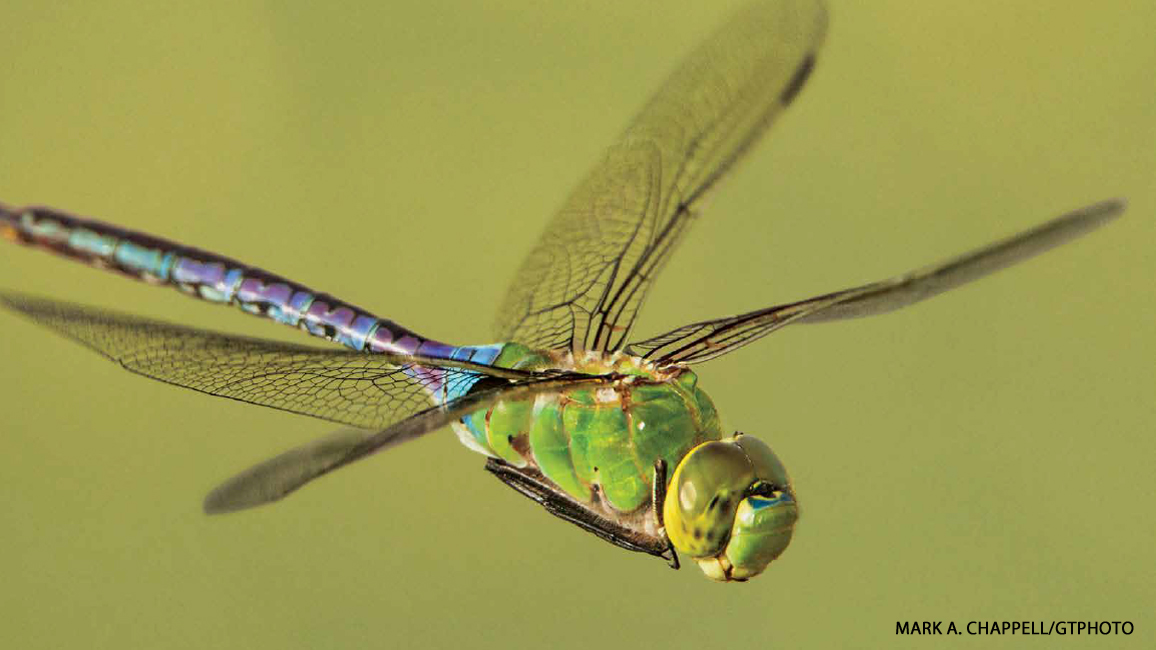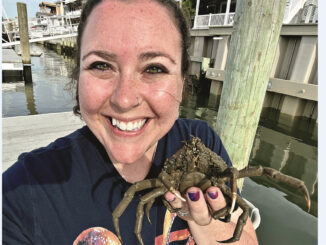
SuperFly!
By Ellen LambethThe dragonfly is a mighty hunter that rules the sky. You have nothing to fear yourself, of course—unless you’re an insect, too.

JEEPERS, WHAT PEEPERS!
Huge, wrap-around eyes can see in every direction at once. Each eye has up to 30,000 tiny lenses. This gives dragonflies the best vision in the insect world.
GRABBY LEGS
A dragonfly uses its spiny front legs to form a net that scoops up prey right out of the air. Flies, mosquitoes, bees, butterflies, and even other dragonflies are often on the menu.
HOME, WET HOME
Dragonflies get their start in life underwater. So a good place to look for the flying adults is around a pond, lake, stream, river, marsh, swamp, or bog.
MIGHTY WINGS
Up to half a dragonfly’s body is made up of muscles that power its four wings. The wings can move together or separately. All this makes the dragonfly an acrobat in the air—and the world’s fastest flying insect!
DRAGONFLY FEATS OF FLIGHT
- Zips along at up to 35 miles per hour.
- Can carry more than twice its own weight in flight.
- Flies up, down, forward, backward, sideways, and upside down.
- Can glide, change direction in a flash, come to a complete halt from top speed, or hover for a minute or more.

GETTING HITCHED
A male dragonfly picks a prize spot near water and fiercely guards it against other males. Then he attracts a female and uses pinchers on his tail end to grab her just behind her head. Sometimes you’ll see a pair flying together this way.
NEW LIFE
After mating, the female lays her eggs underwater. The ones in the circle were laid on the underside of a leaf in the water. As each egg hatches, a young dragonfly will start its underwater life, which may last as long as several years. At this early stage, it will be called a nymph (NIMF).
SHOVEL-MOUTH
The dragonfly nymph below swims by squirting water out its tail end. But most of the time, it keeps still, blending in and waiting to ambush a meal. When it sees a tiny fish or something else to eat, it strikes out with its really fast . . . lower lip? Yep! In the small photo above, you can see the nymph’s head with the lip, called a labium (LAY-bee-um), all the way out. It even has a fork-like tip to stab and grab! After the nymph snags a meal, it reels it into its mouth and folds the labium back under its head. Meanwhile, the jaws take over—chomp, chomp.
THE BIG BREAK-OUT
As the nymph grows, it keeps breaking out of its old, too-tight skin. Finally, it crawls up out of the water on a plant, rock, or beach. The skin breaks open one last time, and out comes a brand new adult—with wings! This one is hanging from its old skin as it pumps fluids from its body into its wings. As soon as the wings are strong enough, this dragon can fly!

BYE-BYE, DRAGONFLY
A lucky dragonfly will zip and zoom through the air, scooping up scads of mosquitoes and other insects to eat. But its luck changes if it ends up at the other end of the food chain—as this one has done. Oh, well—a spider’s gotta eat, too!
WHAT’S THE DIFFERENCE?
Damselflies are close cousins of dragonflies. As you can see below, a damselfly looks slimmer and more delicate. It also rests with its wings held together along its body instead of held out to the sides like a dragonfly’s.
BOTTOMS UP!
A dragonfly is an acrobat both in the air and on a perch. By doing a “headstand,” this one keeps the hot sun from hitting too much of its body directly.
LONG-AGO SUPERFLY
Fossils of dragonflies show that these insects have been around for millions of years. One ancient dragonfly relative was the largest insect ever to live on Earth. Its wingspan was nearly two and a half feet across—five times that of today’s biggest dragonfly!
ALL EYES ON DRAGONFLIES!
VIDEO: WATCH A DRAGONFLY IN ACTION
There are more than 300 species of dragonflies in the United States and about 3,000 around the world. They come in all colors and patterns. And they have cool names such as darners or dashers, skimmers or gliders. Find some quiet waters on a warm, sunny day and go dragonfly-watching!
Poke a tall stick in the mud near the water’s edge and watch awhile. Maybe a dragonfly will choose your stick as a perch. If so, creep up for a closer look. Check out its colors. Can you see its big eyes? Does it turn its head to look at you? When it zooms away, keep watching. Can you tell what its mission is? Does it return to its perch? Look around for shed nymph skins, too.
Keep track of your observations in a dragonfly journal. Or maybe you can help scientists who study dragonflies, especially ones that migrate. For more, have an adult visit xerces.org/dragonfly-migration online.
















